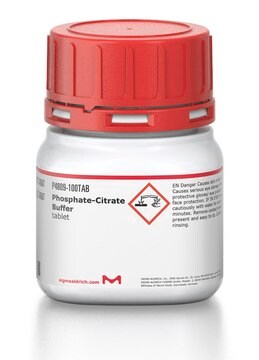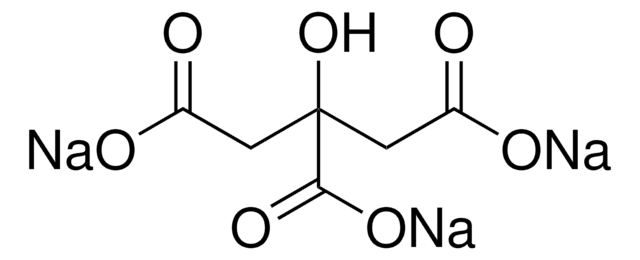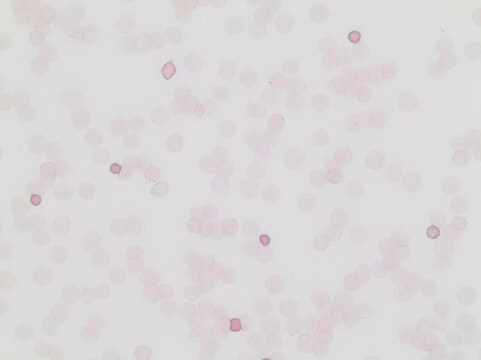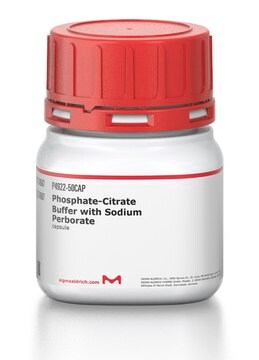C2488
Citrate Buffer Solution, 0.09 M
Synonyme(s) :
Citric Acid Buffer Solution
Se connecterpour consulter vos tarifs contractuels et ceux de votre entreprise/organisme
About This Item
Code UNSPSC :
12161700
eCl@ss :
32129211
Nomenclature NACRES :
NA.25
Produits recommandés
Description
Contains 1% chloroform
pH 4.8 at 25 °C.
Niveau de qualité
Forme
solution
Concentration
0.09 M
pH
4.8 (25 °C)
Application(s)
diagnostic assay manufacturing
Température de stockage
2-8°C
Catégories apparentées
Description générale
Citrate Buffer Solution, 0.09 M, is a high-quality biochemical buffer solution commonly employed in various research applications. Its applications include use in acid phosphatase reactions alongside p-nitrophenyl phosphate (pNPP) enzyme substrate. Citrate Buffer is also used for the isolation of RNA from cells and tissues. In addition, it is also used as a background electrolyte for separating sulfonamides utilizing capillary zone electrophoresis. With its superior buffering capacity and ability to maintain a stable pH, Citrate Buffer Solution, 0.09 M is an excellent choice for any researcher in need of reliable performance.
Application
Citrate Buffer Solution, 0.09 M has been used as a heat-induced antigen retriever on formalin-fixed paraffin-embedded (FFPE) tissue sections during immunohistochemistry (IHC) experiments. It has also been used in the preparation of hybridization solutions for fluorescence in situ hybridization (FISH) procedures.
Autres remarques
Unit definition: One unit of acid phosphatase will hydrolyze 1.0 μmole of p-nitrophenyl phosphate per, minute at pH 4.8 at 37 °C.
Mention d'avertissement
Warning
Mentions de danger
Conseils de prudence
Classification des risques
Carc. 2 - STOT RE 2 Oral
Organes cibles
Liver,Kidney
Code de la classe de stockage
12 - Non Combustible Liquids
Classe de danger pour l'eau (WGK)
WGK 2
Point d'éclair (°F)
Not applicable
Point d'éclair (°C)
Not applicable
Équipement de protection individuelle
Eyeshields, Faceshields, Gloves, type ABEK (EN14387) respirator filter
Faites votre choix parmi les versions les plus récentes :
Déjà en possession de ce produit ?
Retrouvez la documentation relative aux produits que vous avez récemment achetés dans la Bibliothèque de documents.
Les clients ont également consulté
I Gkouveris et al.
Histology and histopathology, 32(10), 1065-1076 (2017-01-17)
Signal transducer and activator of transcription 3 (STAT3) and mitogen activated protein kinases (MAPKs), including ERK and JNK, have been implicated in oral squamous cell carcinoma (OSCC) development and progression. Our purpose was to evaluate the levels of activated STAT3
Argyrios G Daskalopoulos et al.
Oral surgery, oral medicine, oral pathology and oral radiology, 129(5), 493-513 (2020-03-17)
Toll-like receptors (TLRs) may promote or inhibit tumor progression. The aim of this study was to assess the expression of TLR4 and TLR9 and their downstream targets in oral tongue squamous cell carcinoma (OTSCC) in correlation with histopathologic parameters and
Nikolaos G Nikitakis et al.
Oral surgery, oral medicine, oral pathology and oral radiology, 125(2), 164-171 (2017-12-19)
Primary oral malignant melanoma (POMM) is a rare type of malignancy with a very poor prognosis, the molecular pathogenesis of which remains elusive. The aim of this study was to assess the expression status of signal transducer and activator of
Greg C Bristow et al.
Cell reports, 31(3), 107536-107536 (2020-04-23)
Chromosome 16p11.2 duplications dramatically increase risk for schizophrenia, but the mechanisms remain largely unknown. Here, we show that mice with an equivalent genetic mutation (16p11.2 duplication mice) exhibit impaired hippocampal-orbitofrontal and hippocampal-amygdala functional connectivity. Expression of schizophrenia-relevant GABAergic cell markers
Zn2+ efflux through lysosomal exocytosis prevents Zn2+-induced toxicity.
Kukic I, Kelleher SL, and Kiselyov K
Journal of Cell Science, 127(Pt 14), 3094-3103 (2014)
Notre équipe de scientifiques dispose d'une expérience dans tous les secteurs de la recherche, notamment en sciences de la vie, science des matériaux, synthèse chimique, chromatographie, analyse et dans de nombreux autres domaines..
Contacter notre Service technique










